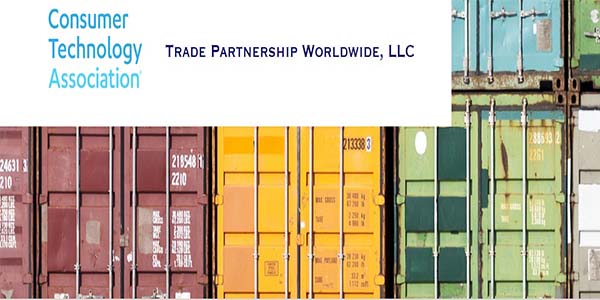The tariffs imposed on Chinese goods, including car audio products, are no longer enticing companies to move production from China and they are not stopping consumers from buying those products, said the Consumer Technology Association (CTA) in a new report.
CTA concludes that companies stopped pulling production out of China two years ago. Plus, US imports from China were higher in 2021 than in 2017 despite tariffs of up to 25 percent, the CTA said.
The tariffs did not lead to more US jobs nor more US exports in computers, printed circuit assemblies, unrecorded media and communications equipment, as examined by the CTA.
“China’s share of U.S. imports of affected tech products nearly halved from 32 percent to 17 percent,” said the CTA. The countries that benefited the most from the tariffs were Vietnam and Taiwan, which saw near-immediate growth in exports to the US.
 The tariffs have caused consumer electronics companies to pay an extra $40 billion to date since 2018 in fees.
The tariffs have caused consumer electronics companies to pay an extra $40 billion to date since 2018 in fees.
The CTA concluded, “China remains a manufacturing base and source of finished technology products… for the United States. In fact, imports of Section 301-affected tech products have risen or leveled off since mid-2020, suggesting that Section 301 tariffs are no longer motivating companies to leave China.“
 PowerBass VP Product Development & Global Marketing Erik Harbour said, “The reason is simple. If I were to move factories to Korea, the quality would be good but the price would be higher. So it’s about the same as paying the tariff. If I moved to the US, the costs would be considerably higher and consumers wouldn’t want to pay for that.”
PowerBass VP Product Development & Global Marketing Erik Harbour said, “The reason is simple. If I were to move factories to Korea, the quality would be good but the price would be higher. So it’s about the same as paying the tariff. If I moved to the US, the costs would be considerably higher and consumers wouldn’t want to pay for that.”
But he added that removing the tariffs alone would not bring down consumer prices much unless shipping costs come down too, and for that to happen, gas prices must also fall back into line.
Back in January, 2020, Maxxsonics, Soundstream and American Bass said they shifted production from China to either the Philippines or Korea.









Tariffs where nothing more than a tax on the middle class. China did not pay these taxes, US manufactures paid them and passed them through to the end user along with the crazy expensive costs and delayed shipping for goods from China, along with record high commodities, like Neodymium being $150,000 per ton up from $80,000, chips with now 2-year lead-times forcing spot buys to brokers at 10 times the individual chips value, these issues are truly driving the inflation we are currently seeing. It did not change our corporate buying habits or move one job back to the USA. Even if we did move some production back, where is the workforce to produce the goods? Skilled production labor is not our expertise. You can tell it was a big multibillion-dollar tax because Biden hasn’t eliminated one of the tariffs even though he campaigned on eliminating them all.
This report is about as illuminating as the ‘Weather Report’ that — “tomorrow the Sun will rise” —
The i’ll-conceived Tariff plan was never going to prompt companies to commit to “on-shoring’” factories, which was wishful thinking, and that tactic would (predictably) have zero impact on tPRC, nor effect their long-term strategy. But it is interesting that the figure for net tariff costs ($40B), none of which was actually ever incurred by China (despite repeated claims), was, in reality, just ‘Step One’ in causing US ‘inflation’ — that we have endured, especially in CE goods, over the past couple years, which is now ‘news worthy.’
If tariffs were actually collected and cycled back to the appropriate industry to promote manufacturing again here in the US, as a subsidy instead of just used for pork, it might actually help to make America competitive again (as originally intended). The fact that we are buying more that ever from China just means more dollars to assists struggling American companies to be able to compete or new manufacturing and jobs.
…you cant do it overnight. Tariffs need to be like a chess game, slow and with a lot of strategy. They needed to start since the first Bush president and we could have controlled China and the exit of just about all of the car audio in the USA. Here is a short list of who I grew up with in Car Audio that used to be made in the USA,
Rockford Fosgate
PPI
Orion
The original Phoenix Gold? not sure!
At least 5 known brands with PCB population from ZED MFG. Ca
I am sure there are more…everyone can chime in.
All have gone to China because at zero to 1.2% tariffs, our nation will never keep up with the cheap labor (that is all you go to China for) well, now they actually build an exceptional product with our money and push.
Trump was on the right path, just too fast and too late for sure. All the tariffs are doing now is lining the Governments pockets. Rumors of them going away? why, it’s free money and it’s paid immediately or you don’t get your shipment.
MMATS still builds 16 models from the first resistor up. Yes, a lot of parts are imported for assembly but they are home-grown and carry a 3-year warranty with in-house 2-3 days repairs.
I hate to sound callous, but these effects should have been obvious. Increasing the costs of China goods doesn’t automatically bring jobs back to the US. It forces those companies to raise prices/move manufacturing to anywhere else with cheap labor. While hurting China’s economy was likely a desired target, it wasn’t how the tariffs were cloaked initially. It was step 1 of making America great again…`
Agree 100% and some companies moved manufactiring like it was intened to do but alot of Companies decided just to pass the price hikes along & never looked they were content